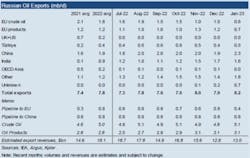IEA: Russian oil exports approached all-time high in January
Russian oil exports rose by nearly 300,000 b/d in January 2023 to 8.2 million b/d, close to the record high reached in February 2020, as crude loads rebounded from December's lows, according to the International Energy Agency (IEA). Product exports were largely steady at around 3.1 million b/d ahead of the European Union (EU) embargo on Russian products, which came into effect in early February. Estimated export revenue edged up by $200 million to $13 billion but was down 36% year-on-year (y-o-y).
Oil exports to the European Union (EU) from Russia fell to 1.3 million b/d, compared with pre-war levels of 3.9 million b/d. Crude shipments slipped to around 600,000 b/d as seaborne volumes dried up with the exception of those destined for Bulgaria, while pipeline flows dropped to 400,000 b/d as Germany voluntarily suspended offtake through the Druzhba.
Russian crude shipments to China rose by 300,000 b/d m-o-m to 2.1 million b/d, the highest on record. Exports to Türkiye rebounded from December’s low of 40,000 b/d to 180,000 b/d; still significantly lower than the 350,000 b/d shipped August-October 2022. While loadings to other destinations were stable overall, new flows to countries such as Ghana (20,000 b/d) and Indonesia (25,000 b/d) emerged, according to IEA.
Product exports were largely unchanged from the previous month, though loadings to the EU dropped from 1.2 million b/d to 740,000 b/d. The biggest decline came in diesel, which fell from 750,000 b/d in December to 470,000 b/d. Product exports to Türkiye and India held steady at around 330,000 b/d and 210,000 b/d, respectively, but were 210,000 b/d and 90,000 b/d higher compared with a year ago. Product flows to other destinations rose by 400,000 b/d to 1.4 million b/d, with the main increase to the Middle East and Latin America
Further reallocation of product trade flows is expected in the coming months, as the EU embargo and Group of Seven (G7) price cap take full effect. EU countries have increased diesel imports from non-Russian sources y-o-y, most notably the US (+90,000 b/d), China (+70,000 b/d) and India (+70,000 b/d). While arrivals of Russian diesel to the EU were still substantial in January, their share of total EU imports fell to 41%.
From January onwards, however, another 740,000 b/d of Russian products previously going to Europe will have to be reshuffled unless Russian refinery output is adjusted to cut overall export levels, IEA said.
